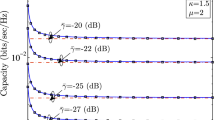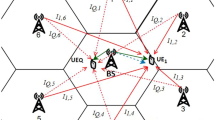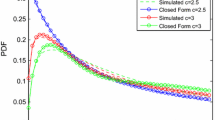Abstract
In this work, the asymptotic performance analysis over double shadowed \(\kappa \)-\(\mu \) fading channel is presented. More specifically, the unified asymptotic tight performance bounds for maximum ratio combining , selection combining and equal gain combining diversity receptions is presented. The system performance in terms of the outage probability (OP), symbol error probability (SEP) (coherent/non-coherent), the average probability of detection, and the average area under the receiver operating characteristic curve (AUC) is studied. To gain more insights and to validate the asymptotic slope of the results, the coding gain and diversity gain for OP, SEP, probability of missed detection, and complementary AUC for all the diversity techniques are also presented. It is found that the asymptotic slope of all the performance parameters and diversity techniques depend only on the number of multipath clusters and the diversity order of the system. Further, simulation results are presented to demonstrate the effectiveness of the proposed methodology under various channel conditions in diverse field of applications, such as vehicle-to-vehicle communication, wearable communication, and wireless power transfer related technologies .







Similar content being viewed by others
References
Simon, M. K., & Alouini, M. S. (2004). Digital communication over fading channels (2nd ed.). New York: Wiley-IEEE Press.
Yacoub, M. (2007). The \(\kappa -\mu \) distribution and the \(\eta -\mu \) distribution. IEEE Antennas Propagation Magazine, 49, 68–81. https://doi.org/10.1109/MAP.2007.370983
Khuwaja, A. A., Chen, Y., Zhao, N., Alouini, M., & Dobbins, P. (2018). A Survey of Channel Modeling for UAV Communications. IEEE Communications Surveys & Tutorials, Fourthquarter, 20(4), 2804–2821. https://doi.org/10.1109/COMST.2018.2856587
Chen, S., Zhang, J., Zeng, W., Peppas, K. P., Ai, B. Performance., & Analysis of Wireless Powered UAV Relaying Systems Over \(\kappa -\mu \) Fading Channels. (2018). IEEE Globecom Workshops (GC Wkshps). Abu Dhabi, United Arab Emirates, 2018, 1–6. https://doi.org/10.1109/GLOCOMW.2018.8644370
Ji, B., Li, Y., Cao, D., Li, C., Mumtaz, S., & Wang, D. (2020). Secrecy performance analysis of uav assisted relay transmission for cognitive network with energy harvesting. IEEE Transactions on Vehicular Technology, 69(7), 7404–7415. https://doi.org/10.1109/TVT.2020.2989297
Panic, S., Perera, T. D. P., Jayakody, D. N. K., Stefanovic, C., & Prlincevic, B. UAV-assited Wireless Powered Sensor Network over Rician Shadowed Fading Channels 2019. IEEE International Conference on Microwaves, Antennas, Communications and Electronic Systems (COMCAS), Tel-Aviv, Israel, 2019: 1-5, https://doi.org/10.1109/COMCAS44984.2019.8958112.
Kumar, S., Soni, S., & Jain, P. (2018). Performance of MRC receiver over hoyt-lognormal composite fading channel. International Journal of Electronics, 105, 1433–1450. https://doi.org/10.1080/00207217.2018.1460870
Chauhan, P. S., Tiwari, D., & Soni, S. K. (2017). New analytical expressions for the performance metrics of wireless communication system over Weibull/Lognormal composite fading. International Journal of Electronics and Communications, 92, 397–405. https://doi.org/10.1016/j.aeue.2017.10.013
Al-Hmood, H., & Al-Raweshidy, H. S. (2017). Unified modeling of composite \(\kappa -\mu \)/Gamma, \(\eta -\mu \)/Gamma and \(\alpha -\mu \)/Gamma fading channel using a mixture gamma distribution with applications to energy detection. IEEE Antennas and Wireless Propagation Letters, 16, 104–108. https://doi.org/10.1109/LAWP.2016.2558455
Chauhan, P. S., Negi, P., & Soni, S. K. (2017). A unified approach to modelling of probability of detection over \(\alpha -\mu \)/IG, \(\kappa -\mu \)/IG, and \(\eta -\mu \)/IG composite fading channels with application to cooperative system. International Journal of Electronics and Communications, 87, 33–42. https://doi.org/10.1016/j.aeue.2018.01.035
Bhargav, N., Silva, C. R. N. D., et al. (2019). Double shadowing the Rician fading model. IEEE Wireless Communications Letters, 8, 344–347. https://doi.org/10.1109/LWC.2018.2871677
Singh, R., Rawat, M., & Pradhan, P. M. (2020). Effective capacity of wireless networks over double shadowed Rician fading channels. Wireless Networks, 26, 1347–1355. https://doi.org/10.1007/s11276-019-02193-2
Ai, Y., Kong, L., & Cheffena, M. (2019). Secrecy outage analysis of double shadowed Rician channels. Electronics Letters, 55, 765–767. https://doi.org/10.1049/el.2019.0707
Bhargav, N., & Silva, C. R. N. D., et al. The double shadowed \(\kappa -\mu \) fading model.2019 International Conference on Wireless and Mobile Computing, Networking and Communications (WiMob), 2019; Barcelona, Spain: 1-6, https://doi.org/10.1109/WiMOB.2019.8923336
Simmons, N., & Silva, C. R. N. D., et al. On shadowing the \(\kappa -\mu \) fading model.IEEE Access, 2020; 8: 120513-120536, https://doi.org/10.1109/ACCESS.2020.3005527.
Singh, R., & Rawat, M. Outage analysis of double shadowed \(\kappa -\mu \) fading channels.2019 10th International Conference on Computing, Communication and Networking Technologies (ICCCNT, )2019, Kanpur, 1-4, https://doi.org/10.1109/ICCCNT45670.2019.8944440.
Singh, R., & Rawat, M. On the performance analysis of effective capacity of double shadowed \(\kappa -\mu \) fading channels.IEEE Region 10 Conference (TENCON 2019), 2019, 806-810, https://doi.org/10.1109/TENCON.2019.8929632.
Wang, Z., & Giannakis, G. B. (2003). A simple and general parameterization quantifying performance in fading channels. IEEE Transaction on Communications, 51(8), 1989–1398. https://doi.org/10.1109/TCOMM.2003.815053
de Tejerina, G. R., da Silva, C. R. N., & Yacoub, M. D. (2020). Extended \(\eta \)-\(\mu \) fading models. IEEE Transactions on Wireless Communications, 19(12), 8153–8164. https://doi.org/10.1109/TWC.2020.3019656
Parente, F. R. A., & Santos Filho, J. C. S. (2019). Asymptotically exact framework to approximate sums of positive correlated random variables and application to diversity-combining receivers. IEEE Wireless Communications Letters, 8(9), 1012–1015. https://doi.org/10.1109/LWC.2019.2904032
Al-Badarneh, Y. H., Georghiades, C. N., & Alouini, M. (2018). Asymptotic performance analysis of the kth best link selection over wireless fading channels: An extreme value theory approach. IEEE Transaction on Vehicular Technology, 67(7), 6652–6657. https://doi.org/10.1109/TVT.2018.2798501
Zhu, B., Yan, J., Wang, Y., Wu, L., & Cheng, J. (2017). Asymptotically tight performance bounds of diversity receptions over \(\alpha -\mu \) fading channels with arbitrary correlation. IEEE Transaction on Vehicular Technology, 66(9), 7619–7632. https://doi.org/10.1109/TVT.2017.2686700
Zhu, B., Cheng, J., Al-Dhahir, N., & Wu, L. (2016). Asymptotic analysis and tight performance bounds of diversity receptions over beckmann fading channels with arbitrary correlation IEEE transaction on. Communications, 64(5), 2220–2234. https://doi.org/10.1109/TCOMM.2016.2543730
Olutayo, A., Cheng, J, & Holzman, J. F. Asymptotically tight performance bounds for equal-gain combining over a new correlated fading channel.15th Canadian Workshop on Inf Theory (CWIT), 2017; Quebec City, Canada, 1-5, https://doi.org/10.1109/CWIT.2017.7994814.
Olutayo, A., Cheng, J, & Holzman, J. F. Asymptotically tight performance bounds for selection diversity over Beaulieu-Xie fading channels with arbitrary correlation.IEEE International Conference on Communications (ICC), 2017; Paris, France, 1-6, https://doi.org/10.1109/ICC.2017.7997182.
Peppas, K. P., Efthymoglou, G., et al. (2015). Energy detection of unknown signals in Gammashadowed Rician fading environments with diversity reception. IET Communication, 9(2), 196–210. https://doi.org/10.1049/iet-com.2014.0170
Gradshteyn, I. S., & Ryzhik, I. M. (2007). Table of integrals, series and products (7th ed.). San Deigo: Academic.
Badarneh, O. S., & Aloqlah, M. S. (2016). Performance analysis of digital communication systems over \(\alpha -\eta -\mu \) fading channels. IEEE Transactions on Vehicular Technology, 65(10), 7972–81. https://doi.org/10.13140/RG.2.1.4046.7925
Prudnikov, A. P., Brychkov, Y., & Marichev, O. I. (1986). Integrals and series volume 2: special functions (1st ed.). New York: Gordon and Breach Science Publishers.
Chauhan, P. S., & Soni, S. K. (2019). Average SEP and channel capacity analysis over Generic/IG composite fading channels: A unified approach. Physical Communications, 34, 9–18. https://doi.org/10.1016/j.phycom.2019.02.003
Pant, D., Chauhan, P. S., & Soni, S. K. (2019). Error probability and channel capacity analysis of wireless system over inverse gamma shadowed fading channel with selection diversity. International Journal of Communication Systems. https://doi.org/10.1002/dac.4083
Chauhan, P. S., Kumar, S., & Soni, S. K. (2019). New approximate expressions of average symbol error probability, probability of detection and AUC with MRC over generic and composite fading channels. International Journal of Electronics and Communications, 87, 119–129. https://doi.org/10.1016/j.aeue.2018.11.006
Bozek, P., Karavaev, Y. L., Ardentov, A. A., & Yefremov, K. S. (2020). Neural network control of a wheeled mobile robot based on optimal trajectories. International Journal of Advanced Robotic Systems, 2, 871.
Pirní, R., Hruboš, M., Nemec, D., Mravec, T., & Božek, P. Integration of Inertial Sensor Data into Control of the Mobile Platform. In Proceedings of the 2015 Federated Conference on Software Development and Object Technologies SDOT 2015. Advances in Intelligent Systems and Computing, 2017; 511.
Semjon, J., Hajduk, M., Jánoš, R., & Vagaš, M. (2013). Modular welding fixtures for robotic cells. Applied Mechanics and Materials, 309, 80–87. https://doi.org/10.4028/www.scientific.net/amm.309.80
Prudnikov, A. P., Brychkov, Y., & Marichev, O. I. (1986). Integrals and series volume 3: more special functions (1st ed.). London: Gordon and Breach Science Publishers.
Bhargav, N., Nogueira da Silva, C. R., Cotton S. L., Sofotasios P. C., & Yacoub, M. D. On Shadowing the \(\kappa \)-\(\mu \) Fading Model, http://arxiv.org/abs/Signal Processing, 2018.
Acknowledgements
This work is a part of Ministry of Electronics and Information Technology (MeitY), Electronics Systems Development and Application Division, Govt. of India sponsored project entitled “Development of IoT and Drone based Agriculture Monitoring System with Objective of Skill Development of Socially Deprived Community” with Project Ref. No.:26(6)/2019-ESDA .
Author information
Authors and Affiliations
Corresponding author
Additional information
Publisher's Note
Springer Nature remains neutral with regard to jurisdictional claims in published maps and institutional affiliations.
Rights and permissions
About this article
Cite this article
Chauhan, P.S., Kumar, S., Upaddhyay, V.K. et al. Generalised asymptotic frame-work for double shadowed \(\kappa -\mu \) fading with application to wireless communication and diversity reception. Wireless Netw 28, 1923–1934 (2022). https://doi.org/10.1007/s11276-022-02922-0
Accepted:
Published:
Issue Date:
DOI: https://doi.org/10.1007/s11276-022-02922-0




